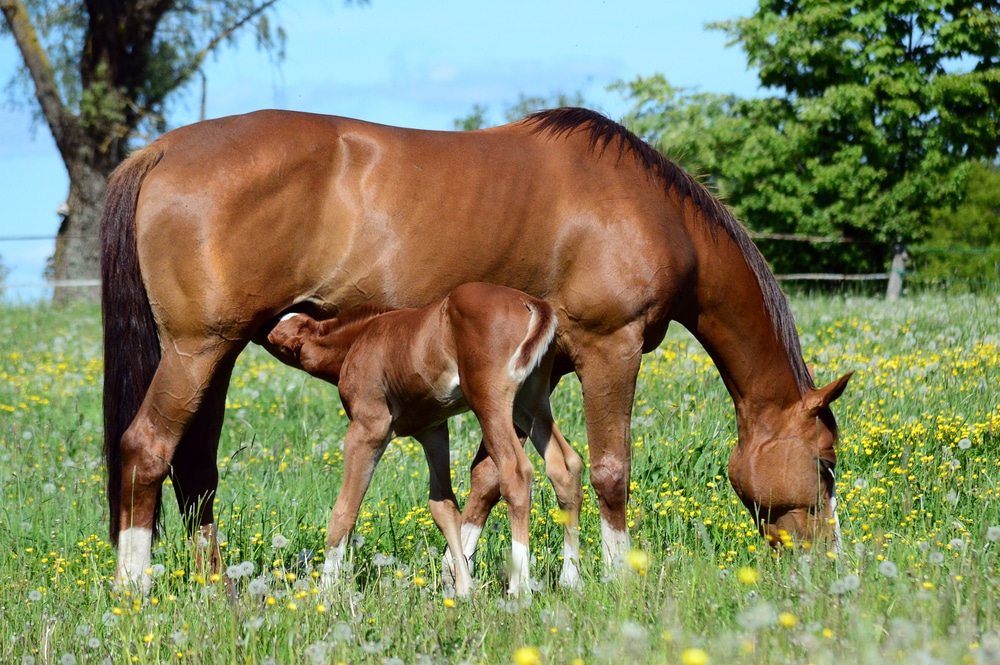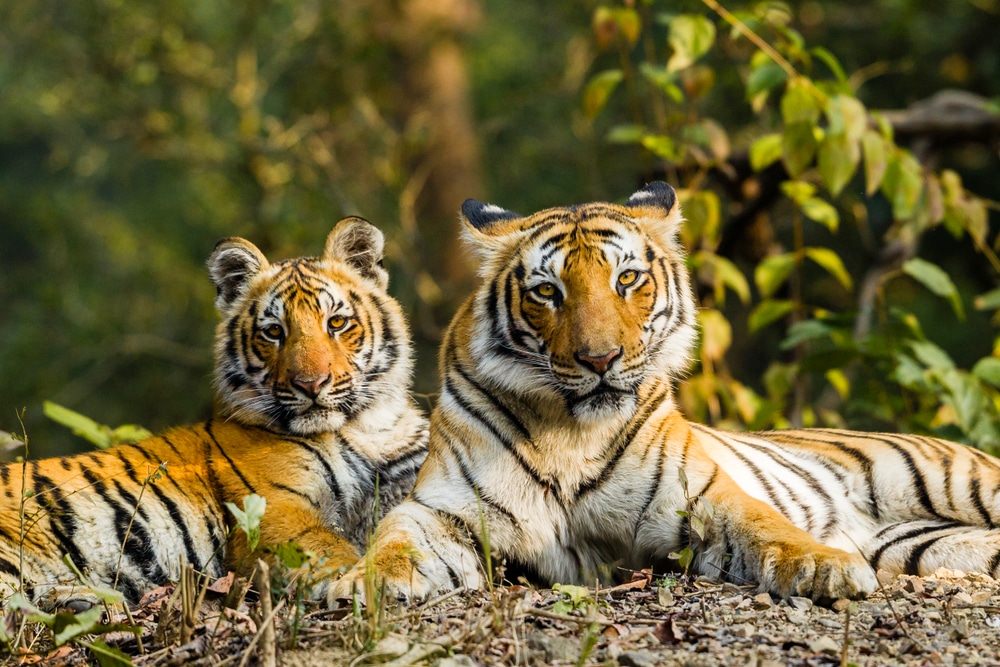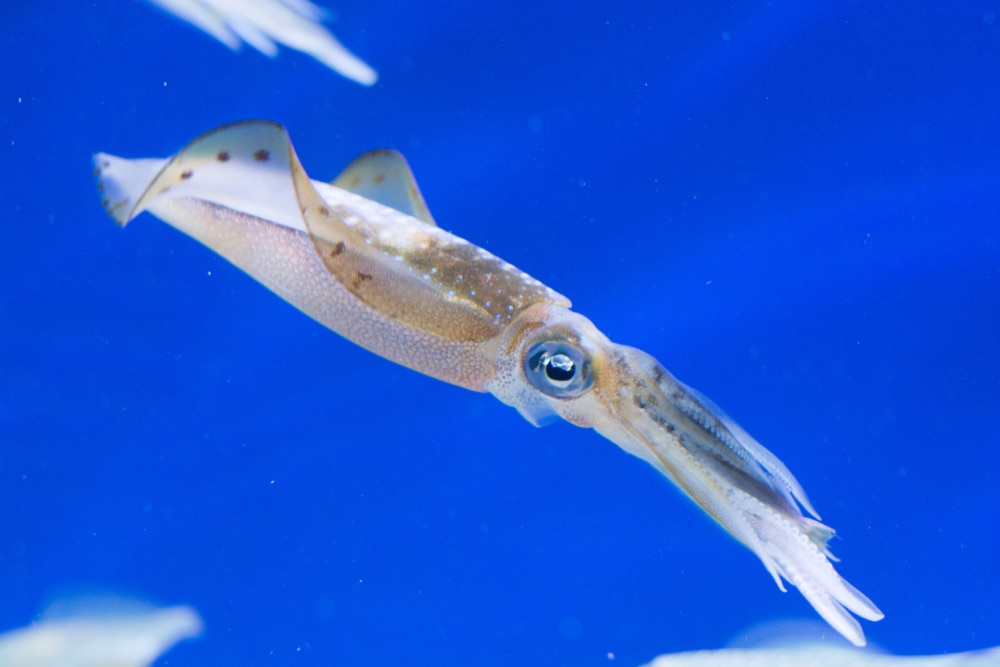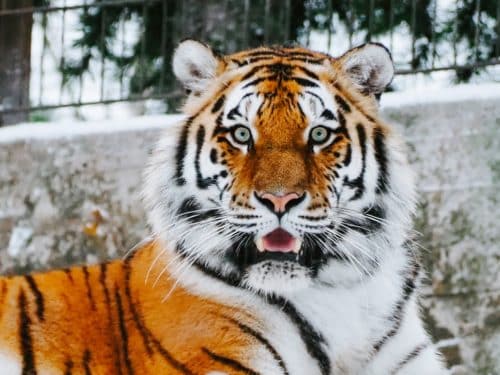
120 Animals in Korean + Cultural Notes
Did you know that Korea was once known as the “land of the people who could tame a tiger”?
In this post, you’ll learn how to say the names of 120 animals in Korean.
But even more than that, this post will share some interesting tidbits about these creatures and the relationship many of them have to Korean culture.
Let’s get started!
Contents
- Pets/Companion Animals in Korean
- Farm Animals in Korean
- Wild Animals in Korean
- Sea Animals in Korean
- Insects/Land Invertebrates in Korean
- How to Talk About Animals in Korean
- And One More Thing...
Download: This blog post is available as a convenient and portable PDF that you can take anywhere. Click here to get a copy. (Download)
Pets/Companion Animals in Korean
Did you know that one out of four Korean households has an animal at home? In Korean, pets are called 애완동물 or 반려동물 .
These days, Korean speakers prefer the term 반려동물 (companions) to 애완동물 (pets) because “pet,” in the sense of “an animal that is loved, cherished, and raised,” implies entertainment to them.
Here are some common Korean companion animals:
1. 고양이 — Cat
Sorry, cat lovers. Your feline friends are apparently associated with bad luck in South Korea, though the government is trying to change that!
고양이가 상자 뒤에 있어요. — The cat is behind the box.
2. 개 — Dog
Although South Korea is a country where dog meat is still eaten, people are starting to see dogs less as “meals” and more as “companions.”
According to a 2021 survey, about 80% of pets in South Korea are dogs. Most of these dogs are considered family members by their owners. We’re sure they’re all good boys and girls!
우리 개는 집 안에 있어요. — My dog is in the house.
3. 개구리 — Frog
Frogs appear frequently in Korean folklore, like in this story about why frogs cry in the rain.
우리 동생은 연못에서 개구리 스무 마리를 봤어요. — My brother saw 20 frogs in the pond.
4. 금붕어 — Goldfish
Goldfish are also popular pets in South Korea, likely due to the fact that they’re relatively low-maintenance.
저는 금붕어 여섯 마리를 기르고 있어요. — I have six goldfish.
5. 도마뱀 — Lizard
Around 110 million years ago, lizards that lived in South Korea ran on two legs.
저는 초록색 도마뱀을 찾고 있어요. — I’m looking for a green lizard.
6. 쥐 — Mouse
The mouse is generally disliked by humans around the world since it’s most often a pest that spreads disease and eats crops.
But Korean culture is a bit kinder to the little rodent, even featuring it in a folktale as a representation of a farmer’s soul that crawls out at night to have an adventure and returns to deliver a prophetic dream to the farmer.
저는 부엌에서 큰 쥐를 봤어요. — I saw a big mouse in the kitchen.
7. 앵무새 — Parrot
There isn’t any particular folklore associated with parrots, though I imagine Korean speakers love them for the same reason we do—they’re just hilarious!
앵무새는 화려해요. — The parrot is colorful.
8. 토끼 — Rabbit
Some say that the Korean peninsula is shaped like a tiger, while others say it’s shaped like a rabbit.
제 친구는 토끼 두 마리가 있어요. — My friend has two rabbits.
9. 뱀 — Snake
If you don’t like snakes, don’t whistle at night when you’re in South Korea! A popular superstition claims that whistling at night can summon snakes (or ghosts, or demons…).
제 가장 친한 친구는 뱀을 무서워해요. — My best friend is afraid of snakes.
10. 거북이 — Turtle
The turtle enjoys a reputation in Korean culture as a symbol of long life, knowledge and the future.
거북이는 굉장히 오래 살아요. — Turtles live a very long time.
Farm Animals in Korean
What’s your favorite 농장 동물 (farm animal)? If you live in a rural area, you may find yourself using these words often.
11. 닭 — Chicken
In traditional Korean weddings, the wedded couple performs a ritual called “gildongyi,” which involves throwing live chickens together to ensure that their marriage will be happy.
농부는 닭 두 마리를 가지고 있어요. — The farmer is carrying two chickens.
12. 소 — Cow
Cows appear prominently in Korean folklore. There are plenty of sayings about them like “without words, the cow has twelve virtues” and “slow but bull’s steps”—both suggesting that the cow is generally held in high regard in the country.
소는 맛있는 우유를 만들어요. — Cows produce delicious milk.
13. 당나귀 — Donkey
South Korea has its own version of the donkey-eared king fairy tale. In this retelling, the only one who knew that the king (named Gyeongmun) had donkey ears was the crown maker. When the crown maker couldn’t keep the secret to himself any longer, he decided to whisper it to a bamboo tree.
As you can imagine, when the winds blew through the bamboo tree, they carried the secret words of the crown maker throughout the kingdom—so the king’s secret was no longer a secret. (Moral lesson: never assume your secrets are safe!)
당나귀는 수레를 끌고 있어요. — The donkey is pulling a wagon.
14. 오리 — Duck
In South Korea, it’s believed that ducks mate for life, making them symbols of marital fidelity. In fact, if you search for “ducks in South Korea,” you’ll find plenty of results related to weddings!
연못에 오리가 100 마리 이상 있다고 생각해요. — I think there are more than 100 ducks in the pond.
15. 염소 — Goat
As strange as it sounds, ancient Koreans consider goats and sheep as the same animal.
염소는 제가 가장 좋아하는 동물이에요. — Goats are my favorite animal.
16. 거위 — Goose
Believe it or not, geese can be great guard animals—even better than dogs in some cases! Just watch this adorable YouTube video of an old lady with her guard geese.
연못에 거위 다섯 마리가 수영을 하고 있어요. — There are five geese swimming in the pond.
17. 말 — Horse
Horses hold a pretty important role in the history of Korea. During the Three Kingdoms Period (57 BCE to 668 CE), little figurines of horses were buried in tombs to carry the spirit of the deceased to the afterlife.
저는 매일 말을 타는 것을 좋아해요. — I like to ride horses every day.
18. 돼지 — Pig
Pigs are another lucky animal in Korean folklore. During some traditional ceremonies or celebrations, a pig-shaped rice cake called 떡 is eaten for the purpose of bringing prosperity and happiness.
돼지는 제가 가장 좋아하는 농장 동물이에요. — Pigs are my favorite farm animals.
19. 양 — Sheep
Want to look like a sheep, Korean style? Check out a popular method of folding a towel called the “Korean towel sheep head” aka the Princess Leia do.
흰 양과 검은 양 두 마리를 봐요. — I see one white sheep and two black sheep.
Wild Animals in Korean
The next time you’re out in nature (or visiting the zoo) you might spot one of these 야생 동물 (wild animals). Here’s how you can say them in Korean.
20. 악어 — Alligator
There are a couple of ways to tell an alligator apart from a crocodile without getting too close for comfort.
When crocodiles have their mouths closed, a single tooth protrudes from the lower jaw. Meanwhile, alligators only have their upper teeth visible when their mouths are closed. And compared to crocodiles, alligator snouts are a bit rounder.
악어는 강력한 이빨과 검은색 피부로 유명해요. — Alligators are famous for their powerful jaws and dark-colored skin.
21. 아르마딜로 — Armadillo
Armadillos are the only living mammal known to have armor around their bodies.
아르마딜로는 스스로를 공 모양으로 말렸어요. — The armadillo rolled itself into a ball.
22. 아홀로틀 — Axolotl
Axolotls don’t only look like cute Pokemons. They also have the ability to regenerate lost limbs and are just amazing animals, period.
아홀로틀은 양서류로, 즉 물과 육지에서 모두 살 수 있다는 뜻이에요. — Axolotls are amphibians, meaning they can live on water and land.
23. 박쥐 — Bat
Bats aren’t as scary as horror movies make them out to be. The largest species, the flying fox, is actually pretty cute when you look at it up close. (Just ignore the fact that some of them can be as large as humans!)
박쥐는 주로 과일, 벌레 및 작은 동물을 먹어요. — Bats primarily feed on fruits, insects and small animals.
24. 곰 — Bear
Bears have an important role in Korean folklore, most notably the legend of 단군 , South Korea’s mythical founder. According to the legend, his mother was actually a shapeshifting bear! (Gives a whole new meaning to “mama bear,” huh?)
숲에 있을 때는 곰을 조심하세요. — Beware of bears when you’re in the forest.
25. 빈투롱 — Binturong
Binturongs are native to Southeast Asia. They also smell like buttered popcorn.
빈투롱은 냄새로 음식과 서식지를 찾는 능력이 뛰어나고, 특유의 냄새로 알려져 있어요. — The binturong has a keen sense of smell and is known for its distinctive scent.
26. 미국 들소 — Bison
Bison are distinctive-looking animals. They’re known for their thick, muscular bodies, disproportionately tiny heads and horns and penchant for gathering in large herds.
미국 들소는 미국의 상징적인 동물이에요. — The American bison is an iconic animal of the United States.
27. 낙타 — Camel
Because camels have humps, they have the ability to survive for weeks without water.
낙타는 사막에서 살아남을 수 있는 동물이에요. — Camels are animals that can survive in the desert.
28. 화식조 — Cassowary
Whatever you do, don’t get anywhere near this bird without the supervision of an animal expert. It may be the last thing you’ll ever do.
화식조는 크고 강력한 다리를 가진 새로 알려져 있어요. — Cassowaries are known for their large and powerful legs.
29. 카멜레온 — Chameleon
Did you know that chameleons can turn their eyes up to 180 degrees? That effectively gives them 360-degree vision!
카멜레온은 색상을 변경할 수 있는 능력을 가지고 있어요. — Chameleons have the ability to change their colors.
30. 치타 — Cheetah
The cheetah is the fastest land animal, able to run at speeds up to 70 mph.
치타는 큰 고양이예요. — The cheetah is a big cat.
31. 침팬지 — Chimpanzee
Chimpanzees are among the primates that are most closely related to humans. In fact, we share around 98.8 percent of our DNA with them!
침팬지는 영리한 영장류예요. — Chimpanzees are intelligent primates.
32. 악어 — Crocodile
You won’t find any crocodiles native to South Korea today, but over 120 million years ago, the country had a giant species of crocodile that could walk on two legs.
악어가 강가에서 일광욕을 즐겨요. — The crocodile sunbathes by the riverbank.
33. 까마귀 — Crow
According to Korean superstition, if a crow caws near a house, it means there will be a death in the family.
까마귀는 검은 깃털을 가지고 있어요. — Crows have black feathers.
34. 사슴 — Deer
Deer are adorable, gentle-looking creatures, but the musk deer—a.k.a “vampire deer” of South Korea probably won’t be getting a Disney special about them any time soon.
숲속에 사슴 세 마리가 있어요. — There are three deer in the woods.
35. 독수리 — Eagle
Eagles aren’t native to South Korea, but there are a couple of species that drop by the peninsula now and then—namely the Steller’s sea eagle and white-tailed eagle.
독수리는 강력한 날개를 가지고 있어요. — Eagles have powerful wings.
36. 코끼리 — Elephant
South Korean elephant Koshik reached international fame for allegedly learning to speak Korean. Hey, if an elephant can do it…
코끼리는 큰 코와 큰 귀를 가지고 있어요. — Elephants have big noses and big ears.
37. 에뮤 — Emu
Emus are a species of flightless bird that only exist in Australia. They also once waged a war against humans—and won the first few rounds, at least.
에뮤는 커다란 몸집과 짧은 날개로 유명해요. — Emus are famous for their large size and short wings.
38. 매 — Falcon
The falcon is notable for how fast it is. In fact, the fastest bird in the world is the peregrine falcon.
매는 빠른 비행 속도로 유명해요. — Falcons are known for their fast flying speed.
39. 플라밍고 — Flamingo
Flamingos have a very distinctive appearance, owing to their curved beaks and long legs. They also have great dance moves!
플라밍고는 아름다운 핑크색 깃털을 가지고 있어요. — Flamingos have beautiful pink feathers.
40. 여우 — Fox
You may have seen the mythical nine-tailed fox in various mediums. It’s even appeared in Pokemon! This is the kumiho (sometimes romanized as “gumiho”) from Korean mythology.
Kumiho are said to be created when a fox lives to 1,000 years, and they have the ability to shift between the shape of a nine-tailed fox and a beautiful girl.
여우는 토끼와 다람쥐를 자주 사냥해요. — Foxes often hunt rabbits and squirrels.
41. 가젤 — Gazelle
Gazelles exist not in South Korea but in the African continent. They look and move gracefully, and they’re also the favorite target of predators such as lions.
가젤은 빠른 속도로 달릴 수 있어요. — Gazelles can run at high speeds.
42. 기린 — Giraffe
The Korean name for the giraffe is also the name of a mythical creature. The 기린 is said to appear only when a great ruler or person is about to arrive.
기린은 목이 길어요. — Giraffes have long necks.
43. 고릴라 — Gorilla
My favorite species of gorilla is the Western lowland gorilla. Its scientific name is—and I swear I’m not making this up—Gorilla gorilla gorilla.
고릴라는 강인한 동물이에요. — The gorilla is a powerful animal.
44. 매 — Hawk
You can think of hawks as slightly smaller versions of eagles.
매들이 높은 나무에 앉아 있어요. — The hawks are perched in the tall trees.
45. 고슴도치 — Hedgehog
There’s one species of hedgehog that lives in South Korea and that’s the Amur hedgehog.
고슴도치는 가시로 덮여 있어요. — Hedgehogs are covered in spines.
46. 하마 — Hippo
Hippos aren’t native to South Korea or any of the religions in the country, so there aren’t any local beliefs associated with them.
아프리카에 가면 하마를 볼 수 있을 거예요. — If you go to Africa, you might see a hippo.
47. 캥거루 — Kangaroo
Kangaroos are marsupials, meaning they are mammals whose young grow up in pouches near their mothers’ bellies.
캥거루는 크게 점프하면서 이동해요. — The kangaroo moves with big jumps.
48. 키위새 — Kiwi bird
Kiwi birds may be tiny and flightless but don’t expect to catch them so easily if you run after them. They can run up to 12 mph, which is faster than most humans!
키위새는 뉴질랜드에서 발견되는 유명한 새예요. — Kiwi birds are famous birds found in New Zealand.
49. 코알라 — Koala
Koalas are one of the few species in the world that can survive off of the toxic eucalyptus tree.
코알라가 나무 위에서 잠들었어요. — The koala fell asleep on the tree.
50. 코모도왕도마뱀 — Komodo dragon
The Komodo dragon is the largest lizard in the world. It detects its prey by flicking out its tongue (much like a snake does). Although it’s not necessarily venomous, its saliva does contain a boatload of bacteria that can infect and kill prey quite quickly!
코모도왕도마뱀은 큰 몸집과 강력한 이빨을 가진 도마뱀이에요. — Komodo dragons are reptiles with large bodies and powerful teeth.
51. 레밍 — Lemming
You won’t find lemmings in South Korea. They’re only in the Northern Hemisphere.
레밍은 꽤 멀리 이동할 수 있는 능력을 가지고 있어요. — Lemmings have the ability to travel quite long distances.
52. 여우원숭이 — Lemur
If you know King Julien from “Madagascar,” he’s a type of ring-tailed lemur. There are plenty of species of lemur, most of them concentrated on the island of Madagascar located southeast of the African continent.
여우원숭이는 높은 나무 꼭대기에 살아요. — Lemurs live on top of tall trees.
53. 사자 — Lion
Although lions have never been native to South Korea, they’re commonly depicted as guardians of temples and other culturally significant places.
동물원에는 사자 네 마리가 있어요. — There are four lions at the zoo.
54. 맨드릴 — Mandrill
Mandrills are the largest species of monkey. They may look like baboons, but they’re much nicer.
맨드릴은 밝은 색상의 얼굴과 긴 이빨을 가진 영장류예요. — Mandrills are primates with bright-colored faces and long teeth.
55. 미어캣 — Meerkat
Timon from “The Lion King” is an example of a meerkat. He’s an unusual one in that meerkats usually hang around groups of their own kind.
미어캣은 사회적인 동물이에요. — Meerkats are social animals.
56. 원숭이 — Monkey
Like other East Asian countries, Korean speakers see monkeys as symbols of cleverness and trickery.
인도네시아에서 원숭이를 봤어요. — I saw monkeys in Indonesia.
57. 말코손바닥사슴 — Moose
If you know anything about North American wildlife, chances are you’ve seen a moose. One of them actually ended up in a convenience store sometime in April 2023!
말코손바닥사슴은 큰 뿔을 가지고 있어요. — Moose have large antlers.
58. 부엉이 — Owl
Did you know owls can turn their heads up to 270 degrees? My neck hurts just thinking about it!
부엉이는 밤에 활동해요. — The owl is active at night.
59. 오랑우탄 — Orangutan
Orangutans are native to Southeast Asia. You can tell them apart from other apes by their reddish-brown to orange fur. If they’re male, they probably have pouches on their cheeks.
오랑우탄은 몸집이 크고 팔이 긴 영장류예요. — Orangutans are primates with large bodies and long arms.
60. 공작새 — Peacock
If you’ve seen the bird we normally associate with the word “peacock,” chances are you’re looking at a male. The female has a much plainer appearance.
공작새가 아름다운 깃털을 펼쳤어요. — The peacock spread its beautiful feathers.
61. 오리너구리 — Platypus
Along with the echidna, the platypus is the only other mammal that lays eggs.
오리너구리는 귀여운 외모를 가지고 있어요. — The platypus has a cute appearance.
62. 북극곰 — Polar Bear
Although South Korea sees its fair share of winters, it doesn’t have any polar bears at all. In fact, polar bears only live in the northern areas of the world.
저는 새끼를 데리고 있는 엄마 북극곰이 귀엽다고 생각해요. — I think polar bear mothers with cubs are cute.
63. 케찰 — Quetzal
Quetzals are birds native to Central and South America. They lend their name to Quetzalcoatl, one of the most important gods in the Mesoamerican pantheon.
케찰은 아름다운 깃털을 가진 새로 유명해요. — Quetzals are famous for their beautiful feathers.
64. 쿼카 — Quokka
Quokkas may look like rodents, but they’re actually marsupials. Like most marsupials, they can only be found in Australia—specifically, Rottnest Island.
쿼카는 로트네스트 아일랜드에서만 볼 수 있는 작은 몸집과 독특한 얼굴을 가진 동물이에요. — Quokkas are animals with small bodies and unique faces found on Rottnest Island.
65. 너구리 — Raccoon
Oddly enough, even though raccoons aren’t native to South Korea, they have a word for them!
너구리는 귀여운 얼굴을 가지고 있어요. — Raccoons have cute faces.
66. 순록 — Reindeer
Unfortunately, the only reindeer you’ll see in South Korea are Christmas decorations (though that does beg the question of why they have a word for “reindeer” in the first place).
순록은 크리스마스에 많이 언급돼요. — Reindeer are often mentioned during Christmas.
67. 코뿔소 — Rhino
You can’t find rhinos in South Korea, though there’s a species in South Korea’s (relatively) close neighbor Indonesia.
코뿔소는 겉모습과는 달리 인간보다 더 빨리 달릴 수 있어요. — Despite their appearance, rhinos can run faster than humans.
68. 도롱뇽 — Salamander
In 2005, a new species of lungless salamander was found in South Korea. Instead of breathing through its lungs (which, as its name suggests, it doesn’t have), it breathes through its skin!
도롱뇽은 양서류예요. — The salamander is an amphibian.
69. 나무늘보 — Sloth
Sloths may not look like they do much, but you won’t believe how strong their cores are!
나무늘보는 나무에서 매우 느리게 움직여요. — Sloths move very slowly in the trees.
70. 다람쥐 — Squirrel
There’s only one flying squirrel species in South Korea, and that’s the Siberian flying squirrel.
다람쥐는 나무에서 뛰어다녀요. — Squirrels run around in trees.
71. 맥 — Tapir
If the elephant is smaller and had a much shorter trunk, it would probably look like a tapir. Tapirs aren’t native to South Korea, but neighboring Asian countries like Japan have legends about them like the baku or the “eater of dreams.”
맥은 멸종 위기에 처해있는 동물 중 하나로 보호받고 있어요. — Tapirs are one of the endangered animals and are under protection.
72. 안경원숭이 — Tarsier
You might not think of tarsiers as primates, since they don’t look anything like monkeys, apes or humans. But they are, and their large eyes help them see in the dark to help them hunt their main source of food: insects.
안경원숭이는 큰 눈과 긴 다리를 가진 영장류예요. — Tarsiers are primates with big eyes and long legs.
73. 태즈메이니아 데빌 — Tasmanian devil
The Tasmanian devil has one of the strongest bites (relative to their size) of any mammal. They’re also a character in Looney Tunes cartoons!
태즈메이니아 데빌은 작고 강력한 이빨을 가지고 있어요. — The Tasmanian devil has small but powerful teeth.
74. 호랑이 — Tiger
Tigers have a special place in Korean lore and folktales, as they used to be a big presence on the Korean peninsula.
If you spend some time in South Korea, you can expect to see tiger statues around the temples and cities. You might even spot a tiger-adorned crest on the badges of some military officers, representing the tiger’s strength and ferocity.
In fact, Korea has a reputation as the “Land of the Tigers” and the tiger is considered the unofficial symbol of North and South Korea.
호랑이는 제 여동생이 가장 좋아하는 동물이에요. — Tigers are my little sister’s favorite animal.
75. 왕부리새 — Toucan
Toucan beaks aren’t only distinctive. They also have air-filled cells inside them, making them far lighter than they look!
왕부리새는 멋진 부리를 가지고 있어요. — Toucans have amazing beaks.
76. 늑대 — Wolf
Wolves are currently extinct in South Korea, though there have been efforts to clone the animal.
늑대는 무서운 포식자예요. — Wolves are fearsome predators.
77. 웜뱃 — Wombat
You may have heard about how wombats have square feces. But did you know their pouches also face backward? That’s so the dirt won’t get into their pouches when they dig their burrows.
윔뱃은 털로 덮인 둥근 몸통과 짧은 다리를 가진 동물이에요. — Wombats are animals with furry, rounded bodies and short legs.
78. 얼룩말 — Zebra
Zebras are also not native to South Korea and therefore don’t appear in their folklore. But they’re beautiful creatures nonetheless!
얼룩말은 흑백 말처럼 보여요. — Zebras look like black and white horses.
Sea Animals in Korean
Since South Korea is part of a peninsula, it makes sense that 해양 동물 (sea animals) or 해양 생물 (sea life) are part and parcel of Korean culture.
Also, if you’re a seafood lover and you’re planning a visit to South Korea, the Noryangjin Fish Market—where merchants peddle everything from shellfish to jellyfish—is a must-visit.
79. 잉어 — Carp
Like in neighboring East Asian countries, the carp is considered a symbol of strength and perseverance in Korean culture.
잉어는 호수나 강에서 주로 발견돼요. — Carps are commonly found in lakes and rivers.
80. 조개 — Clam
In South Korea, clams can be eaten on their own or used as soup stock.
조개는 모래 속에 살아요. — Clams live under the sand.
81. 산호초 — Corals
Corals are animals that look more like plants than animals. They also play a vital role in maintaining marine ecosystems by providing homes to fishes and the sea creatures we just mentioned.
저는 해양 생물들이 산호초 주변에서 아름다운 풍경을 만들어 낸다고 생각해요. — I think marine creatures create beautiful scenery around corals.
82. 게 — Crab
South Korea is a haven for raw crab dishes like 간장게장 (raw crab in soy sauce).
해변에 게가 여섯 마리 있어요. — There are six crabs on the beach.
83. 돌고래 — Dolphin
If you live near the islands of Jeju, you may see Indo-Pacific bottlenose dolphins.
돌고래는 매우 빠르게 수영할 수 있어요. — Dolphins can swim very fast.
84. 뱀장어 — Eel
In South Korea, eels are eaten during the summer season in the belief that they provide added energy and stamina.
뱀장어는 먹다 보면 좋아하게 될 거예요. — Eels are an acquired taste.
85. 해파리 — Jellyfish
If you’ve ever seen a jellyfish, you know what a beautiful creature it is. That is unless you’re one of the unlucky people who saw a gigantic Nomura’s jellyfish back in 2008 along the South Korean coastline!
저는 수영할 때 해파리를 자주 봐요. — I often see jellyfish when swimming.
86. 바닷가재 — Lobster
If you want to find lobsters in South Korea, you’ll need to drop by some of the high-end restaurants there as it is considered a luxury food item.
저녁 식사로 바닷가재를 먹었어요. — I had lobster for dinner.
87. 고등어 — Mackerel
South Koreans traditionally eat 고등어 구아 (grilled mackerel) on certain days of the lunar calendar to combat the summer heat.
고등어는 맛있는 생선 중 하나로 유명해요. — Mackerel is famous for being a delicious fish.
88. 문어 — Octopus
Octopi are common in Korean cuisine—most (in)famously in 산낙지 (raw live octopus).
문어는 바다에 살아요. — Octopuses live in the ocean.
89. 꽁치 — Pacific Saury
In South Korea, Pacific saury are eaten during the chillier times of the year in the belief that it gives warmth and strength to the body.
꽁치는 가을에 한국 해역에서 많이 잡히는 어종이에요. — Pacific saury is a fish species that is commonly caught in Korean waters during the autumn.
90. 펭귄 — Penguin
Penguins aren’t native to South Korea, but let’s be honest: they’re some of the cutest birds around.
펭귄은 어색하게 걸어요. — The penguin walks awkwardly.
91. 연어 — Salmon
Salmon isn’t a common fish in South Korea. However, it is often used in fusion Korean cuisine.
연어는 강을 거슬러 올라가 어류의 생명주기를 완성해요. — Salmon swim upstream to complete their life cycle.
92. 성게 — Sea Urchin
Sea urchins look more like weird plants than animals, but their roe is quite excellent!
성게는 독특한 모습과 가시로 둘러싸여 있어요. — The sea urchin has a unique appearance and spines.
93. 해마 — Seahorse
Believe it or not, the seahorse is a fish, even if it doesn’t look like one. Also, unlike many animals, it’s the males that get pregnant rather than the females.
해마는 독특한 모양을 가진 물고기의 한 종류예요. — The seahorse is a type of fish with a unique shape.
94. 물개 — Seal
Like many languages around the world, the word for “seal” in Korean means “water dog”—which, if you’ve ever seen a seal, is pretty accurate!
물개는 게으른 동물이에요. — Seals are lazy animals.
95. 상어 — Shark
South Korea’s Pinkfong is the creative force behind the abysmally catchy song that everyone’s heard at least 1,000 times by now: “Baby Shark.” And now it’s stuck in your head again. You’re welcome!
바다에 있을 때는 상어를 조심하세요. — Beware of sharks when you’re in the ocean.
96. 새우 — Shrimp
Compared to lobster, shrimp is a more down-to-earth ingredient and is pretty common in Korean dishes.
새우에 알레르기만 없었다면, 전 새우를 좋아했을 텐데요. — I would’ve loved shrimp if I wasn’t allergic to it.
97. 오징어 — Squid
This cephalopod doesn’t only lend its name to the hit 2021 TV series. It’s also a staple in Korean food like 오징어볶음 (spicy stir-fried squid).
한국에서는 사람들이 자주 오징어를 먹어요. — People often eat squid in Korea.
98. 불가사리 — Starfish
Unlike most of the animals listed so far, starfish isn’t consumed in South Korea. Instead, you’ll find them in aquariums and other marine-themed settings.
불가사리는 극피동물이에요. — Starfish are echinoderms.
99. 참치 — Tuna
You may normally associate tuna with Japanese cuisine (mostly notably sushi), but it’s also an important fish in South Korean dishes like 회 (raw tuna).
참치는 바다에서 빠른 속도로 헤엄쳐요. — Tuna swim at high speeds in the ocean.
100. 고래 — Whale
In ancient Korea, whales were worshiped as deities.
고래는 물고기처럼 보이지만 물고기가 아니에요. — Even though whales look like fish, they’re not fish.
Insects/Land Invertebrates in Korean
Of course, like most of the world, South Korea has its fair share of creepy crawlies (although your mileage may vary on whether they can actually be considered “creepy.”) Here are some land invertebrates and their Korean names.
101. 개미 — Ant
Who hasn’t heard of ants? These ubiquitous beasties love gathering around food when they can find them!
개미는 작은 곤충이에요. — Ants are small insects.
102. 벌 — Bee
Bees can seem dangerous due to their sting, but they play an important role—namely, the production of honey, which is used in Korean dishes like 고기구이 where honey can be used as a glaze.
벌은 꽃에서 꿀을 만들어요. — Bees produce honey from flowers.
103. 딱정벌레 — Beetle
One species of rhinoceros beetle is specially raised in South Korea to treat ailments like diabetes and liver disease.
어릴 때, 저는 딱정벌레를 잡는 것을 좋아했어요. — When I was a child, I liked to catch beetles.
104. 나비 — Butterfly
Some Korean speakers say that, if you touch a butterfly and then touch your eyes, you’ll go blind!
나비는 아름다운 날개를 가지고 있어요. — Butterflies have beautiful wings.
105. 지네 — Centipede
Centipedes are one of those animals that genuinely creep me out. There’s something about a wormlike creature with multiple legs crawling about your house that’s so unsettling.
지네는 다리가 많은 곤충이에요. — Centipedes are insects with many legs.
106. 바퀴벌레 — Cockroach
Do cockroaches need any further explanation? I know that whenever I see one of these creepy crawlies, I get the urge to flatten it with my footwear.
왜 바퀴벌레는 죽이기가 어려울까요? — Why are cockroaches so hard to kill?
107. 귀뚜라미 — Cricket
If you hear chirping sounds during nights in the South Korean countryside, chances are you’re hearing crickets.
가끔 저는 메뚜기와 귀뚜라미를 혼동해요. — Sometimes, I confuse grasshoppers with crickets.
108. 잠자리 — Dragonfly
Dragonflies are keystone species, meaning their presence (or lack thereof) is a good indicator of the health of the surrounding environment. If there are dragonflies in an area, that’s usually a good sign!
잠자리는 깨끗한 곳에서만 나타난다고 해요. — It’s said that dragonflies only appear in places that are clean.
109. 반딧불이 — Firefly
Like dragonflies, fireflies are a keystone species. If you’re lucky enough to find them in South Korea, they’re quite the sight!
저는 밤에 반딧불이를 구경하는 것을 좋아해요. — I love watching the fireflies at night.
110. 메뚜기 — Grasshopper
Grasshoppers appear in a number of Korean folktales, and there’s a unique-looking cafe named after them.
메뚜기는 높이 뛰어올라서 날아갈 수 있어요. — Grasshoppers can jump high and fly.
111. 말벌 — Hornet
South Korea is home to the Asian giant hornet, which may or may not have deserved the nickname “murder hornet.”
말벌은 크고 강력한 독을 가지고 있어요. — Hornets have a large amount of potent venom.
112. 무당벌레 — Ladybug
Ladybugs are pretty little insects. You can tell them apart from the others by the distinctive red-with-black-spots pattern on their backs. And since they eat plant-eating insects, farmers are more than happy to have them around!
무당벌레는 작은 빨간 단추처럼 보여요. — Ladybugs look like little red buttons.
113. 모기 — Mosquito
There aren’t any specific Korean folklore about mosquitoes, though you can imagine that Korean speakers are just as annoyed with them as most of us are!
모기는 짜증나요! — Mosquitoes are annoying!
114. 사마귀 — Praying Mantis
Praying mantises have a distinctive appearance. They have long front legs designed to capture and trap prey. Also, as their name suggests, they look like they’re praying!
사마귀는 사마귀의 이름을 딴 무술이 있어요. — Praying mantises have a martial art named after them.
115. 전갈 — Scorpion
Scorpions aren’t native to South Korea, but you may find some people keeping them as exotic pets.
전갈은 독을 가지고 있어요. — Scorpions have venom.
116. 민달팽이 — Slug
Because moisture is essential to a slug’s survival, you won’t find them in dry areas.
민달팽이는 체액을 이용하여 움직여요. — Slugs move using their body fluid.
117. 달팽이 — Snail
Like in other parts of the world, snails are a delicacy in South Korea. For example, the whelk is a sea snail that’s a common ingredient in a dish called 골뱅이무침 (spicy whelks with noodles)
오늘 비가 와서 달팽이들이 땅에 나왔어요. — It rained today, so snails came out on the ground.
118. 거미 — Spider
In South Korea, it’s believed that if you come across a spider in the morning, you’ll have good luck. That’s because spiders are associated with hard work, seeing as they spend all day building their webs.
저는 거미를 무서워해요. — I have a fear of spiders.
119. 흰개미 — Termite
If you’re in a house with a lot of wooden structures, make sure you watch out for termites!
흰개미들은 목재 가구를 파괴해요. — Termites destroy wood furniture.
120. 말벌 — Wasp
Wasps seem like innocuous creatures at first until you find out about how they reproduce. (Let’s just say it’s the stuff of horror movies!)
벌과 말벌은 같지 않아요. — Bees and wasps aren’t the same.
How to Talk About Animals in Korean
Now that you know the vocabulary words themselves, let’s learn how to use them in conversation.
The Origin of the Word 동물 (Animal)
The Korean word for animal is 동물. Like many words in Korean, each character has a Chinese origin. The word 동물 can be broken into two parts.
동 → 動 — Movement
물 → 物 — Thing
Learning the Chinese characters that Korean words are derived from can help you build your vocabulary. If you want to learn more Chinese characters used in Korean, How to Study Korean has a great guide.
Counting Animals in Korean with 마리
Counting in Korean is a bit different from counting in English. That’s because Korean uses counters attached to nouns to quantify them.
The counter for counting animals is 마리. Here are a few examples of how you’d use this counter:
개가 세 마리 있어요. — I have three dogs.
고양이 네 마리를 봐요. — I see four cats.
Using Animal Words in a Sentence
Korean can be a difficult language to learn since the grammar is so different from English. Luckily, you can use animal words in the same way as you’d use any other nouns, and you don’t need to learn any unusual rules.
Here’s a sentence you might find useful when talking about animals in Korean:
가장 좋아하는 동물은 _____ 이에요/예요. — My favorite animal is _____.
To hear all these new terms in authentic contexts, you can check out FluentU.
If you enjoyed this post, you're already halfway to having the time of your life learning Korean with FluentU!
FluentU makes it possible to learn with K-pop videos, funny commercials, entertaining web series and more. Just a quick look will give you an idea of the variety of FluentU videos on offer:
FluentU really takes the grunt work out of learning languages, leaving you with nothing but engaging, effective and efficient learning. It's already hand-picked the best videos for you (which are organized by level and topic), so all you have to do is simply choose any video that strikes your fancy to get started.
Each word in the interactive captions comes with a definition, audio, image, example sentences and more.
Access a complete interactive transcript of every video under the Dialogue tab, and easily review words and phrases from the video under Vocab.
You can use FluentU’s unique Quiz Mode to learn the vocabulary and phrases from the video through fun questions.
FluentU keeps track of what you're learning, and tells you exactly when it's time for review, giving you a 100% personalized experience.
Review sessions use video context to help embed the words in your memory.
Start using the FluentU website on your computer or tablet or, better yet, download the FluentU app from the iTunes or Google Play store. Click here to take advantage of our current sale! (Expires at the end of this month.)
And One More Thing...
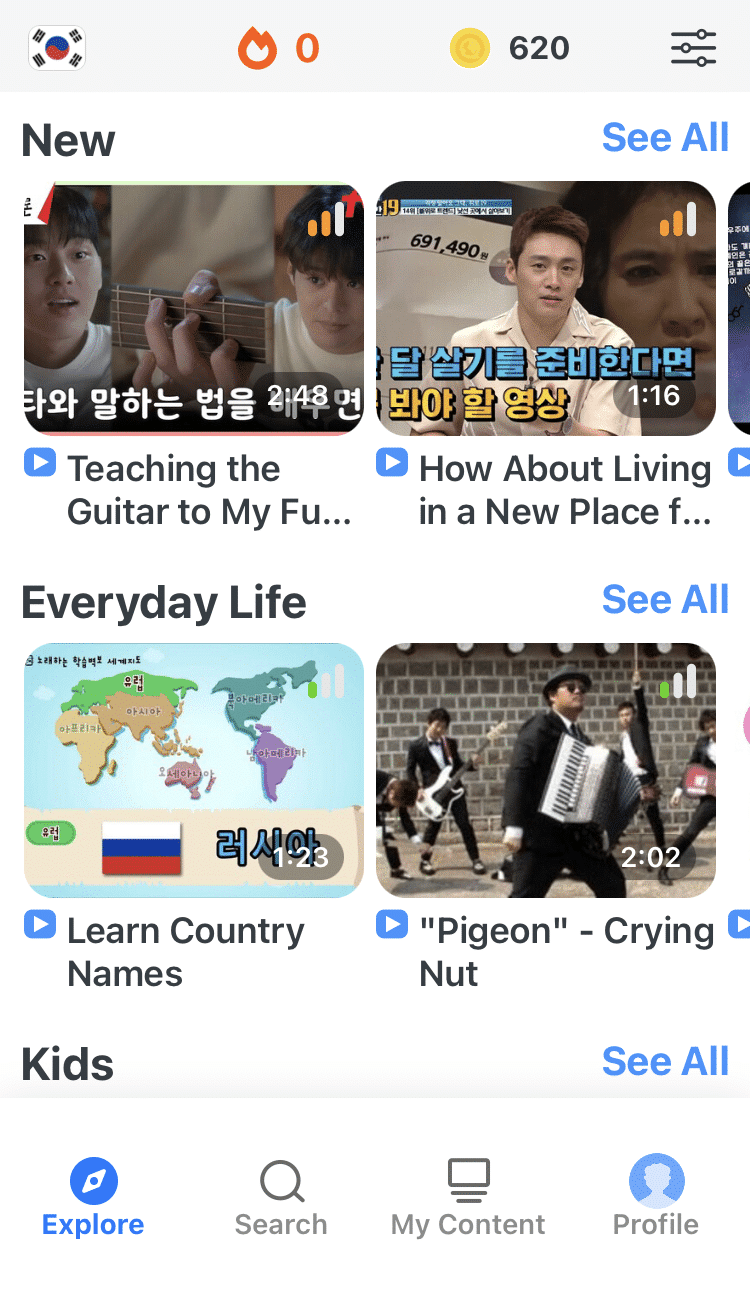

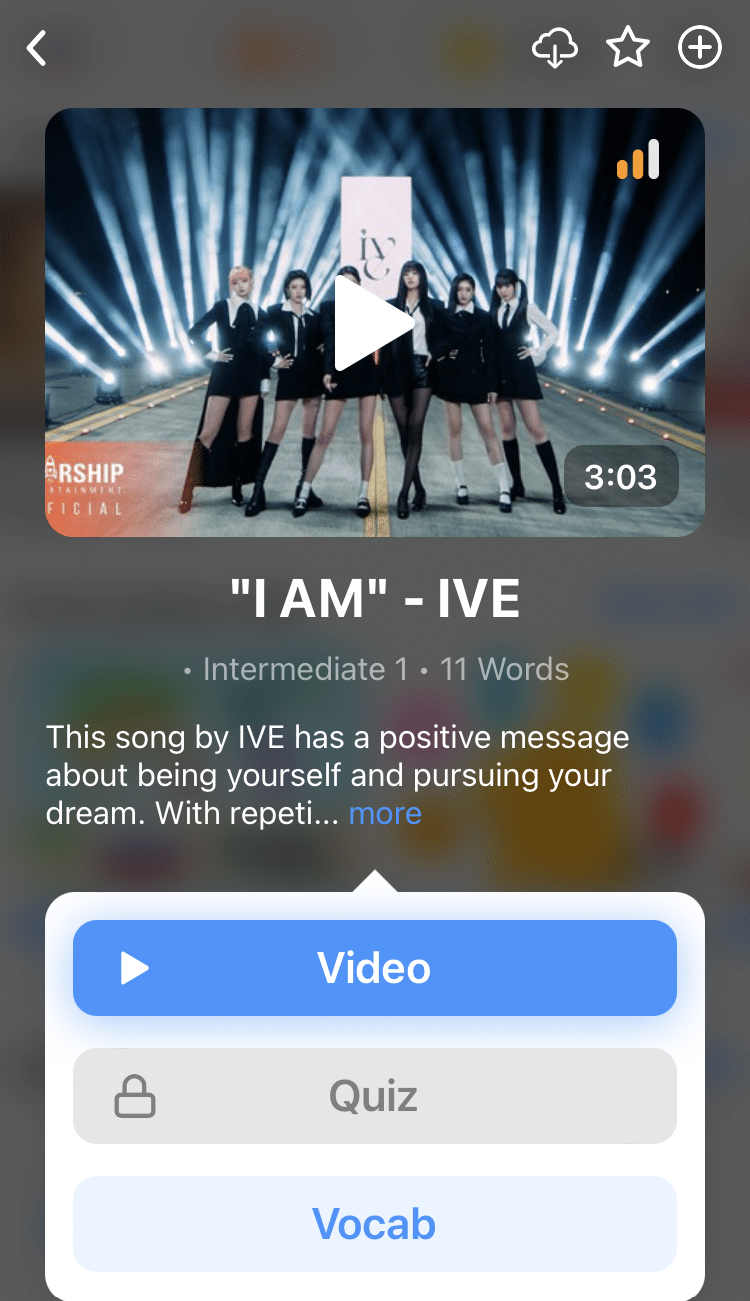
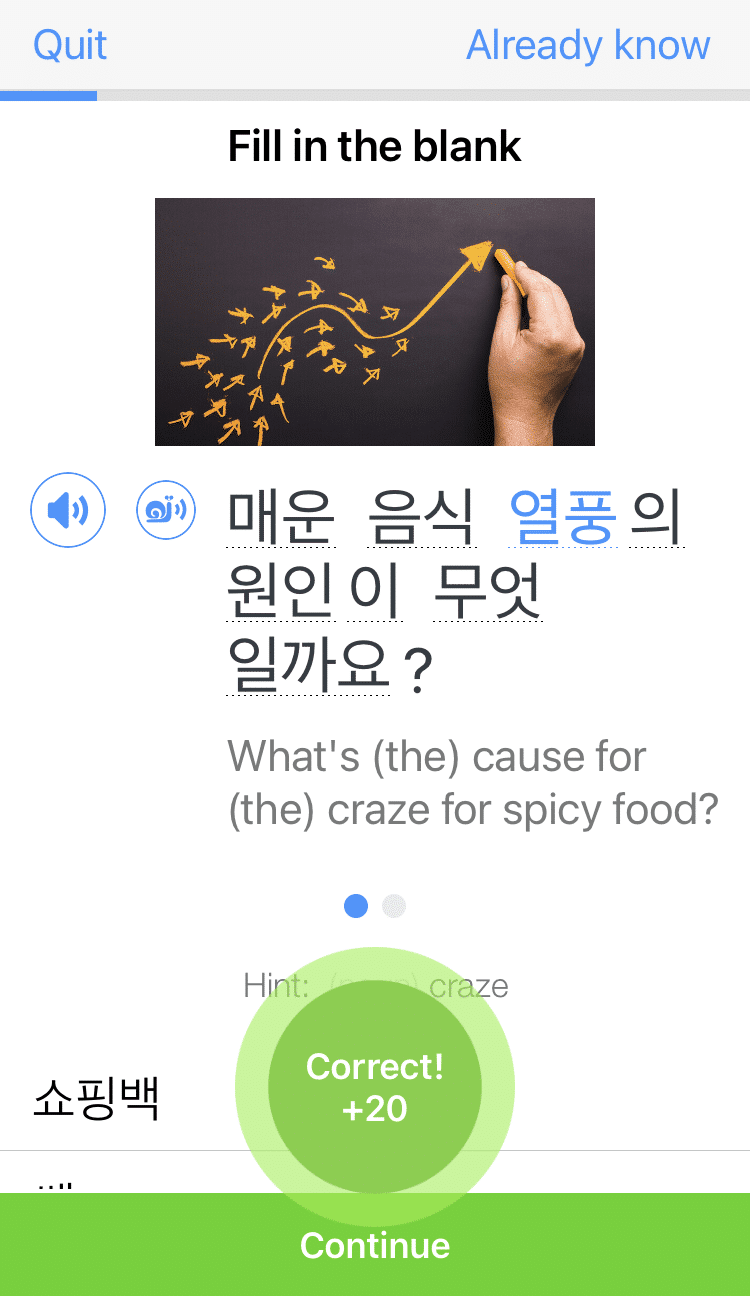
Use your new vocabulary words as you walk around your city/town, or visit the zoo or aquarium for a challenge!
Or, you can watch some Korean documentaries about animals on a language-learning platform or app.
Either way, 120 animals in Korean is a lot to remember, so try to get some review in however you like!
Download: This blog post is available as a convenient and portable PDF that you can take anywhere. Click here to get a copy. (Download)
FluentU takes authentic videos—like music videos, movie trailers, news and inspiring talks—and turns them into personalized language learning lessons. You can try FluentU for free for 2 weeks. Check out the website or download the iOS app or Android app. P.S. Click here to take advantage of our current sale! (Expires at the end of this month.)

